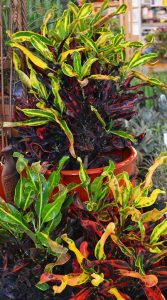Croton Mammy

- Botanical Name:
- Family Name:
- Stems:
- Temperature:
- Others:
Overview
Product Description
Croton Mammy: The Tropical Palette Master
The Tropical Tango: A Guide to the Croton Mammy’s Charm and Care
The Tropical Favorite
Croton Mammy, scientifically known as Codiaeum variegatum ‘Mammy’, is an indoor plant famous for its colorful and variegated leaves. It hails from the tropical regions of Malaysia, Indonesia, Australia, and the western islands of the Pacific, where it can grow into a shrub up to 9 feet tall, becoming a vibrant part of the tropical rainforest landscape.

Croton Mammy
Growth Elegance: The Bushy Artist
Croton Mammy is noted for its dense, bushy growth habit, reaching an average height of 2-3 feet when mature. Its leaves are long and finger-like, developing slight twists and spiral curls as they grow, creating crinkled edges that make each leaf a work of art in nature.
Light Requirements: The Dancer of Sunlight
Croton Mammy requires plenty of bright, indirect sunlight to maintain the vibrant colors of its leaves. It dislikes direct sunlight and is not suited to complete shade, so it’s best to place the plant near a south or west-facing window, slightly away from the window to prevent direct sunlight from hitting the leaves, or use sheer curtains or light shades as a buffer.
Water and Temperature: The Guardian of Humidity
Croton Mammy prefers consistently moist but not soggy soil and thrives in indoor temperatures between 60-80°F, with a preference for high humidity levels of 40-80%. Always check the soil before watering to ensure it’s not over- or under-watered. Avoid placing the plant directly on a windowsill where direct light is too strong, and also avoid north-facing windows which do not provide enough sunlight. Croton Mammy does not tolerate extreme temperature changes and requires careful care to maintain its health and beauty.
The Vibrant Vogue of Croton Mammy: A Symphony of Form and Color
The Majestic Form
Croton Mammy is renowned for its unique morphological features. It is a succulent plant with long, pointed leaves that typically display a vibrant green hue, accented with yellow, red, or orange variegations. These variegations not only add visual appeal to the plant but also serve as indicators of its health status. The leaves of Croton Mammy are usually leathery, smooth, and glossy, making them appear particularly lively under light. The shape and size of the leaves can vary, but they are typically elongated oval with slightly wavy or twisted edges, adding a natural beauty.
The Play of Light and Temperature

Croton Mammy
Light is one of the primary factors affecting the leaf color of Croton Mammy. Adequate indirect light can promote the synthesis of pigments in the leaves, particularly carotenoids and anthocyanins, which give the leaves their yellow, orange, and red hues. If light is insufficient, the leaves may lose their vibrant colors and become dull. Temperature also affects the leaf color of Croton Mammy, with lower temperatures affecting the synthesis and distribution of pigments, showing more vibrant autumnal colors. Extreme temperature changes, whether too hot or too cold, can harm the plant, affecting its color and health.
The Vitality of Water and Nutrients
The right amount of water is crucial for maintaining the health and color of Croton Mammy. Overwatering or drought can lead to changes in leaf color, usually causing the leaves to turn yellow or develop spots. Keeping the soil slightly moist but not waterlogged is key to maintaining its color. The nutritional status of the plant also affects its leaf color. A deficiency in certain nutrients, such as nitrogen, phosphorus, and potassium, can lead to changes in leaf color. Regular fertilization, ensuring the plant receives balanced nutrition, can help maintain its vibrant colors.
The Balance of Soil pH
The acidity or alkalinity of the soil also affects the synthesis of pigments in Croton Mammy’s leaves. Although this plant has a strong adaptability to soil pH, the best growth and color performance are usually achieved in slightly acidic to neutral soil. With careful care and management, this plant can display its most enchanting colors and forms, becoming a dynamic living entity influenced by a variety of factors.










